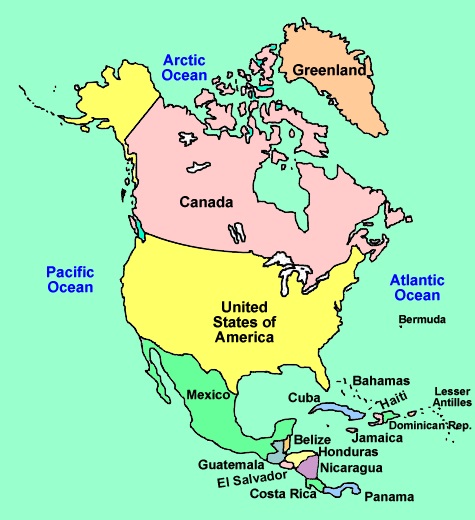
Third in size among the world's continents, lying for the most part between the Arctic Circle and the Tropic of Cancer, North America extends for more than 5,000 miles (8,000 kilometres) to within 500 miles of both the North Pole and the Equator and has an east-west extent of 5,000 miles. It covers an area of 9,355,000 square miles (24,230,000 square kilometres).Mainland North America is shaped roughly like a triangle, with its base in the north and apex in the south.
North America is bounded on the north by the Arctic Ocean, on the east by the North Atlantic Ocean, on the south by the Caribbean Sea, and on the west by the North Pacific Ocean. To the northeast, Greenland is separated from Iceland by the Denmark Strait, and to the northwest, Alaska is separated from the Asian mainland by the much narrower Bering Strait; North America's only land connection is to South America at the narrow Isthmus of Panama.
The name America is derived from that of the Italian merchant and navigator Amerigo Vespucci, one of the earliest European explorers to the New World. Although at first the term America was applied only to the southern half, the designation soon was applied to the entire landmass; those portions that widened out north of the Isthmus of Panama became known as North America, and those that broadened to the south became known as South America. According to some authorities, North America begins not at the Isthmus of Panama but at the narrows of Tehuantepec, with the intervening region called Central America. Under such a definition, part of Mexico must be included in Central America, although that country lies mainly in North America proper. To overcome this anomaly, the whole of Mexico, together with Central and South American countries, also may be grouped under the name Latin America, with the United States and Canada referred to as Anglo-America.
North America's geologic structure is built around a stable platform of Precambrian rock called the Canadian (Laurentian) Shield.
The continent is richly endowed with natural resources, including great mineral wealth, vast forests, immense quantities of fresh water, and some of the world's most fertile soils. These have allowed North America to become one of the most economically developed regions in the world, and its inhabitants enjoy a high standard of living.
Although North America has considerable climatic variety, five principal climatic regions can be identified. The northern two-thirds of Canada and Alaska, as well as all of Greenland, have subarctic and arctic climates, in which long, dark, bitterly cold winters alternate with brief, mild summers. Most of the region, which receives relatively little precipitation, is covered with snow and ice during much of the year.
The native wildlife of North America was once numerous and diverse, but the spread of human settlement has resulted in contracting habitats and diminishing numbers. In general, the fauna of North America is similar to that of the northern areas of Europe and Asia. Notable large mammals include several kinds of bear, the largest being the grizzly; bighorn sheep; bison, now only in protected herds; caribou; moose, called elk in Europe; musk ox; and wapiti.
North America's first inhabitants are believed to have been ancient Asiatic peoples who migrated from Siberia to North America sometime during the last (Wisconsin) glacial advance. The descendants of these people, the various Indian and Eskimo people, largely have been supplanted by people from the Old World. People of European ancestry constitute the largest group, followed by those of African and of Asian ancestry; in addition there is a large group of Latin Americans, who are of mixed European and Indian ancestry.